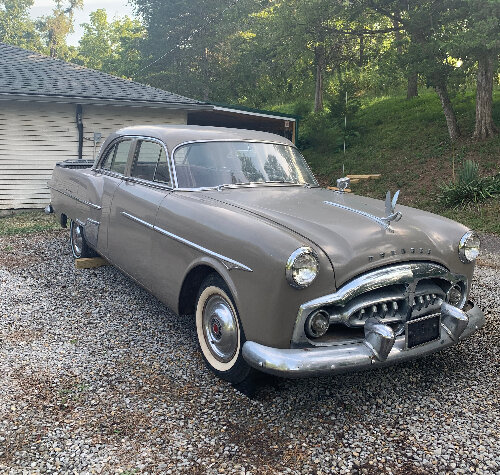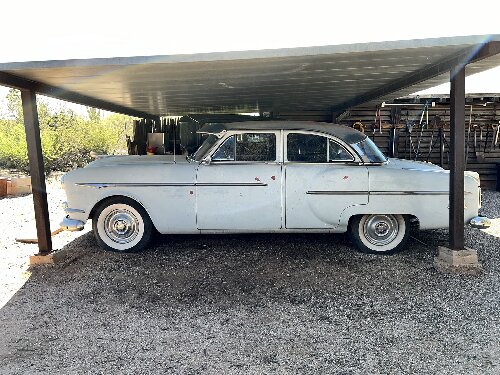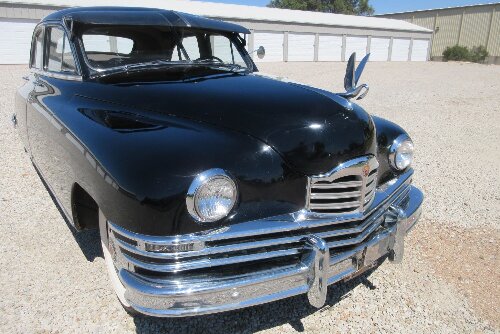|
Re: rear main seal
|
||||
|---|---|---|---|---|
|
Home away from home
|
Sadly, that does look like the seal although I am at a loss as to how it got there. Pulling the pan and the rear main cap will tell the tale.
When was it installed? I laboriously installed a seal in a 55 Carry beans about 20 years ago that mysteriously turned to mush in a couple of days. Laboriously installed another and it was fine. I surmise it was too tight, overheated, and consequently broke down. It is of course a pain to change the upper half in the car even with a "Sneakey Pete". A helpful trick is to form the new upper half ahead of time in the main bearing cap: install the seal per normal procedure in the cap, install the cap, torque it, and even turn the engine some to burnish it in. Let it stand some time to "set". Then carefully remove your beautifully formed new seal from the cap and with the crankshaft lowered as far as you can install it in the block. OH! Nearly forgot--one time I got a set of bearings for a 356 where the chamfer at the edge where the two halves meet was cut improperly. This enabled high pressure oil in the bearing groove to shoot out the rear of the bearing directly toward the seal. No rope seal can handle that even when properly installed, and over time that volume of oil might have washed out the seal.
Posted on: 2015/4/11 6:48
|
|||
|
||||
|
Re: rear main seal
|
||||
|---|---|---|---|---|
|
Home away from home
|
Thanks Ross,
The engine was rebuilt about a year ago and while I have run it in the garage it has not been on the road. I appreciate the tips. I will be talking to my rebuilder and looking for some help on this one. I was really surprised to see all that junk in there. Thanks Ross, Mark
Posted on: 2015/4/11 14:39
|
|||
|
||||
|
Re: rear main seal
|
||||
|---|---|---|---|---|
|
Home away from home
|
I removed the oil pan and my mechanic came over to pull the rear cap. As suspected the rope seal shredded in short order. No clear explanation.
The shop found a suitable rubber seal and so far no leaks. The seal is for a Chrysler slant six, backed with a .040 shim. I think the Fel-Pro number is 91020.
Posted on: 2015/5/10 22:22
|
|||
|
||||
|
Re: rear main seal
|
||||
|---|---|---|---|---|
|
Home away from home
|
Well, after about 15 miles of test driving a leak is back in the same general area of the rear seal/clutch cover. Just wondering if it might be a leak from the oil pan and not the rear seal. Is there a way I can tell for sure where the leak is before launching into seal replacement again?
And, just wondering if anyone has successfully replaced the rope seal with rubber/neoprene on a 356?. Other posts reported success on the V8's. Thanks folks, Mark
Posted on: 2015/5/26 18:54
|
|||
|
||||
|
Re: rear main seal
|
||||
|---|---|---|---|---|
|
Home away from home
|
Is is a 1940? Did you seat the seal before assembly?
Posted on: 2015/5/26 20:49
|
|||
|
||||
|
Re: rear main seal
|
||||
|---|---|---|---|---|
|
Home away from home

|
Hi all,
Sorry to hear about that leaking seal. Since my dads engine is in the shop this very moment what advice can I give the machinist on preventing such a disaster? THANKS!!! Bill
Posted on: 2015/5/26 21:31
|
|||
|
Bill,
Dedicated to keeping the man who owns one on the road!!! |
||||
|
||||
|
Re: rear main seal
|
||||
|---|---|---|---|---|
|
Home away from home
|
Bill,
From my research and recent experience, probably the best thing would be a test stand run so that you can fix a seal problem before engine installation. That option was not available to me short of making my own test stand. I have talked at length to my engine guy and I don't think he would have done anything differently during assembly. He has done hundreds of rope seals with no issues, so this one is a mystery. Good luck, Mark
Posted on: 2015/5/26 21:55
|
|||
|
||||
|
Re: rear main seal
|
||||
|---|---|---|---|---|
|
Forum Ambassador

|
I also would look into why the graphite rope seal failed. With an undamaged surface on the crankshaft and properly installed the rope seal should easily last the service life of the engine without leaking. Granted that installing them properly is a bit of a chore.
Posted on: 2015/5/26 22:08
|
|||
|
||||
|
Re: rear main seal
|
||||
|---|---|---|---|---|
|
Home away from home
|
I can give you the story behind my 1940 rear seal. I can also tell you that two longtime L.A. Packard mechanics have told me to leave the rear seal alone if it only leaks a bit, the modern rear rope seals do not last. On two occasions installed by experienced Packard men, started leaking within two weeks. This was about two years ago, and do not recommend the latest rope seal guaranteed not to leak, it does.
Why I ask is 1940 because the troughs are deeper and give very little support to the rope seal. Have been told it was corrected for 1941. When my engine was rebuilt about twenty five years ago, would not leak for about 200 miles, then would start to leak. Had experienced mechanics replace a few times, did it my self a couple times over about a two year period. While doing these replacements, would talk to many machine shops, looking for someone old enough that had experienced this, and had a remedy. Finally one shop gave me the name and number of a fellow that had owned a company called L.A. Piston. A machine shop he had owned from the thirties, and actually worked with Studebaker, Ford companies on refinements with the engine rebuilding process, and issues with rear rope seals. He told me several things. Make sure the seal is seated properly. Drill a small hole in the trough of the bottom cap, cut off the tip of a nail, and stick it in the hole point above the surface just a bit, to prevent the rope seal from shifting because of the rotation of the crank shaft. And find wicking material. I had never heard of it, but he stated if you find a machine shop that had been around long enough, they will carry it. After many calls, and driving around all the oldest machine shops in L.A. finally went to one, and the older gentleman said no has asked for that in probably thirty years, but I have a box of Fel Pro Soft Wicking Material. Did you know it is asbestos, and not allowed to have it! I said oh? Can I have just a bit? He said I am not supposed to have this anymore, and not used it in thirty years, you take it. When you use it make sure you have a mask on. Wicking material is a soft fibered oil soaking fibre material that expands to fill gaps. In this case where the rope seals meet, and a gap can happen. I did the nail thing, and used the wicking material on both sides where the seal comes together. After about 14000 miles, it is just now starting to leak, and compression is starting to drop, so for me it lasted the life of the engine, now time to rebuild. That's my story use anything that might help. I am sure someone has better ideas. And being farily new to Las Vegas, can anyone recommend an experienced engine machine shop? Thanks
Posted on: 2015/5/26 22:57
|
|||
|
||||

 (95.06 KB)
(95.06 KB)







